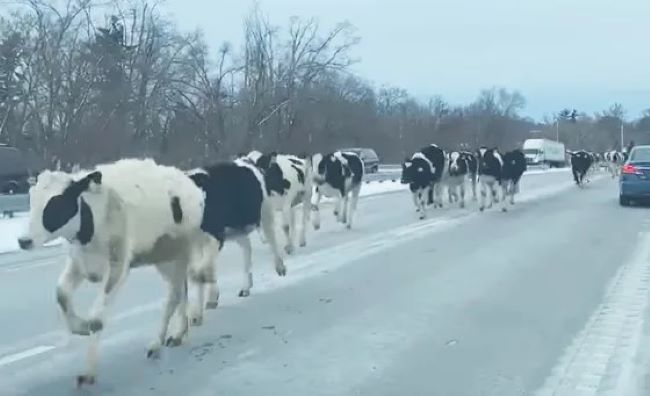 India prides itself on being a nation that worships cows, and both Union and State governments have spared no effort—or funds—when it comes to cow welfare. Millions of rupees are funneled annually into cow protection schemes, often marketed as a testament to the country’s commitment to animal welfare. Yet, ironically, the streets of cities and towns are littered with stray cows, blocking traffic, causing accidents, and turning daily commutes into a gamble with fate.
India prides itself on being a nation that worships cows, and both Union and State governments have spared no effort—or funds—when it comes to cow welfare. Millions of rupees are funneled annually into cow protection schemes, often marketed as a testament to the country’s commitment to animal welfare. Yet, ironically, the streets of cities and towns are littered with stray cows, blocking traffic, causing accidents, and turning daily commutes into a gamble with fate.
Despite official announcements of hefty allocations to cow shelters and protection boards, the reality on the ground tells a different story. In several cities, cows roam freely across highways, narrow lanes, and busy intersections. Drivers swerve to avoid them, two-wheelers skid, and pedestrians find themselves navigating an unpredictable obstacle course. Reports of fatal accidents involving stray cows are disturbingly frequent, sparking questions about the effectiveness of the so-called “Cow Funds.”
Experts and local residents alike point to the glaring gap between policy and execution. While bureaucrats boast about expenditures on cow welfare, the money often fails to translate into functional shelters, proper feeding, or veterinary care. Many cows are left abandoned or poorly managed, forced to fend for themselves on the streets, ironically turning urban roads into dangerous pastures.
Traffic authorities have repeatedly warned that stray cattle pose an acute public safety risk. Yet, the enforcement of existing rules remains lax, shelters are overcrowded or under-equipped, and funds are either delayed or mismanaged. Citizens are left to pay the ultimate price, with human lives endangered daily, all while official statistics celebrate “success stories” of cow welfare programs.
The situation has also sparked broader debates about accountability and governance. Critics argue that the massive sums spent on cow protection often serve political optics rather than tangible outcomes. “We see roads turned into cow corridors while billions are supposedly spent on cow funds,” notes a traffic safety analyst. “It’s high time the authorities realize that animal welfare cannot come at the cost of human lives.”
Advocacy groups suggest practical solutions: enforce strict penalties for abandoned cattle, establish real-time monitoring of cow shelters, implement rapid-response teams for stray cow removal, and ensure that funds actually reach operational shelters rather than sitting idle in government accounts. Without such measures, the so-called “Cow Fund” risks becoming a tragic comedy of errors—one where humans pay the ultimate price, quite literally.
In essence, while India continues to celebrate its cultural reverence for cows, the streets reveal a grim contradiction. Human lives remain vulnerable, commuters remain anxious, and the gap between policy rhetoric and ground reality grows ever wider. Until the authorities take decisive, on-ground action, the irony will persist: billions spent to protect cows, while people struggle to survive a daily game of dodging them on the roads.
The Stray Cattle Menace:
According to the 2020 livestock census, India is home to over 5 million stray cattle .These animals often scavenge garbage dumps, causing traffic disruptions and posing health risks. Between 2018 and 2022, stray cattle were responsible for over 900 human deaths in Haryana alone. Similarly, Bhubaneswar relocated approximately 200 stray cattle to prevent accidents during the Durga Puja festivities However, these measures have proven insufficient. In Chhattisgarh, over five and a half years, 404 people lost their lives, and 129 were seriously injured in accidents involving stray cattle In Bhopal, between July and September 2024, 192 cows were killed on state highways, highlighting the severity of the issue
To address the stray cattle crisis effectively, experts suggest:
Enhanced Enforcement: Stricter penalties for abandoning cattle and better enforcement of existing laws.
Public Awareness: Campaigns to educate farmers and the public about responsible cattle management. Infrastructure Development: Investment in shelters and facilities for stray cattle to reduce their presence on roads. While the allocation of funds for cow welfare reflects India’s cultural values, the persistent issue of stray cattle on roads underscores a gap between policy and implementation. Without comprehensive strategies that include enforcement, education, and infrastructure development, the safety of commuters will remain at risk.
Odisha’s Initiative: The Odisha government plans to implement a driver warning system to reduce car-cattle collisions, identifying at least six hotspots for such accidents
Bhubaneswar’s Proactive Measures: Ahead of the Durga Puja festivities, Bhubaneswar relocated 200 stray cattle to prevent accidents and ensure smooth celebrations